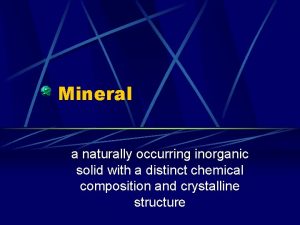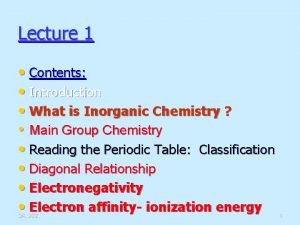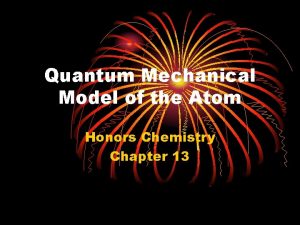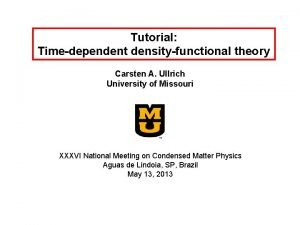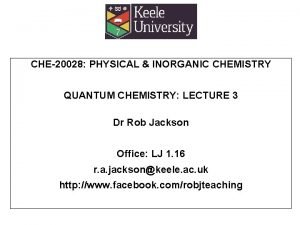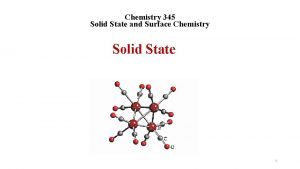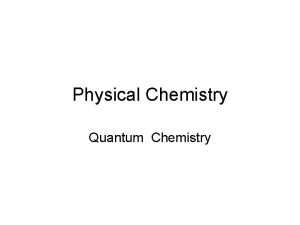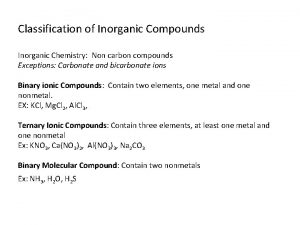CHE30042 Inorganic Physical Solid State Chemistry Advanced Quantum


















- Slides: 18

CHE-30042 Inorganic, Physical & Solid State Chemistry Advanced Quantum Chemistry: lecture 1 Rob Jackson LJ 1. 16, 01782 733042 r. a. jackson@keele. ac. uk www. facebook. com/robjteaching @robajackson

Background reading Recommended Atkins’ Physical Chemistry, 9 th edition Peter Atkins, Julio de Paula Supplementary (more detailed) Quantum Mechanics for Chemists David O Hayward (RSC Tutorial Chemistry Text no. 14) che-30042: Advanced QC lecture 1 2

Lecture 1 contents 1. Recap from CHE-20028 – – – Schrödinger Equation: solution for model systems (particle in box, harmonic oscillator) Hydrogen atom – energies and orbitals Hydrogen-like orbitals 2. Wavefunctions for ‘many-electron’ atoms – – – Determinant notation introduced Wavefunctions for He – C The Self-Consistent Field Method che-30042: Advanced QC lecture 1 3

Recap. of material from CHE-20028– (i) • Schrödinger equation: H = E – Note – operator algebra - the Hamiltonian, H acts on the wavefunction, to give the energy, E. • Particle in a box: permitted energies are: En = n 2 h 2/8 m. L 2 (with n = 1, 2, 3. . . ) • Harmonic oscillator: H= – ‘x’ is the particle displacement – En = (n+½) (n = 0, 1, 2 , 3 …) (giving zero point energy) che-30042: Advanced QC lecture 1 4

Recap. of material from CHE-20028– (ii) • The hydrogen atom – Hamiltonian is H = Te + Vne, or written in full: H = (-ħ 2/2 m) 2 -e 2/4 0 r – (check che-20028 slides for definitions). – Wavefunction is written as: (r, , ) = R(r) Y( , ) – ‘s’ orbitals only depend on r, while ‘p’ orbitals (onwards) also depend on ( , ). – ‘hydrogen-like’ orbitals assume no electron repulsion. che-30042: Advanced QC lecture 1 5

Hydrogen-like orbitals • The orbitals widely used in Chemistry (1 s, 2 p, 3 s, 3 p, 3 d etc. ) are known as hydrogen-like orbitals because in their ‘ideal’ form they only apply to hydrogen (with no electron repulsion), or to other 1 electron ‘atoms’ like He+, Li 2+ etc. • A link to a good diagram will be given (also see teaching pages). Also see next slide. che-30042: Advanced QC lecture 1 6

Screenshot from http: //csi. chemie. tu-darmstadt. de che-30042: Advanced QC lecture 1 7

Atoms with more than 1 electron (i) • For He, we might write the wavefunction as 1 s 2, shorthand for • This means electron 1 in 1 s with spin up and electron 2 in 1 s with spin down. • Wavefunctions have to satisfy the Pauli Exclusion Principle, which states that the wavefunction must change sign if the electrons are interchanged. che-30042: Advanced QC lecture 1 8

Atoms with more than 1 electron (ii) • So the wavefunction for He is written as: – Note that the (1/√ 2) term is a normalising factor. • The expression can be simplified by using determinant notation (will be written and explained in lecture). – Look up determinants and how to solve them. Links will be provided to useful web resources. che-30042: Advanced QC lecture 1 9

Atoms with more than 1 electron (iii) • The determinant notation can be used to simplify the expressions for wavefunctions of atoms with more electrons. – Li will be done in the lecture – Self-test: try Be, B & C • Using this procedure we can (in principle) write out the wavefunction of any atom in terms of orbitals. – Note: expressions for the orbitals are still needed. che-30042: Advanced QC lecture 1 10

Correcting hydrogen like orbitals: the Self. Consistent Field method • We can write the wavefunction of an atom in terms of orbitals, e. g. for Li: = 1 s 2 2 s 1 (or in determinant notation to take into account the Pauli Exclusion Principle). • Each term is a 1 -electron orbital, so how is electron repulsion taken into account? • This is done using the Self-Consistent Field method. che-30042: Advanced QC lecture 1 11

The Self-Consistent Field (SCF) method – (i) • The s, p, d, f … orbitals that we are familiar with are 1 -electron orbitals – i. e. they don’t take into account the presence of other electrons. • The SCF method provides a way of correcting wavefunctions for the presence of more than one electron. • This can explain, e. g. , why electrons in 4 s orbitals have lower energy than those in 3 d orbitals in K and Ca • How has this been explained up to now? che-30042: Advanced QC lecture 1 12

The Self-Consistent Field (SCF) method – (ii) • What is the Hamiltonian for a 1 -electron atom? • It will include 2 terms: electron kinetic energy (Te) and electron-nucleus potential energy (Vne). H = Te + Vne • If we have more than one electron, there will be an additional term due to electron-electron repulsion (Vee): H = Te + Vne + Vee • (Note there will generally be more than one Te and Vne term). che-30042: Advanced QC lecture 1 13

The Self-Consistent Field (SCF) method – (iii) • There is a problem in calculating the electron repulsion energy because we are using 1 -electron orbital wave functions – i. e. each orbital only contains one electron, so how can we explain how they interact? • The SCF method provides a way of correcting orbitals for the effect of other electrons. • It starts by calculating the average potential energy of interaction between the first electron and the others (i. e. Vee in the previous equation). This is done assuming 1 -electron orbitals. che-30042: Advanced QC lecture 1 14

Application of the SCF method – (i) • If we now consider a particular example, Be, which has electronic structure 1 s 22 s 2 (ignoring spin and antisymmetry for now), we follow this procedure: – (i) calculate the Vee term assuming 1 -electron orbitals. – (ii) solve the Schrödinger equation for the 2 s orbital using this Vee term. – (iii) This gives a new updated 2 s orbital. che-30042: Advanced QC lecture 1 15

Application of the SCF method – (ii) – (iv) using the new 2 s orbital obtained, the Vee term is recalculated, and the Schrödinger equation solved for the 1 s orbital. – (v) An updated 1 s orbital is obtained, and this is then used to amend the value of Vee, which is then used to recalculate the 2 s orbital. – (vi) The procedure is then repeated until there is no change in the orbitals and their energies in successive calculations. che-30042: Advanced QC lecture 1 16

Application of the SCF method – (iii) • For Be, the ordering of the orbitals will not be affected, but in the case of K and Ca, the energy of the 4 s orbital will be found to be lower than 3 d at the end of the calculation, explaining the orbital occupancies. • A problem with the SCF method is that it does not treat electron correlation (i. e. electrostatic repulsion) properly, and this has to be corrected for, using Configuration Interaction calculations. che-30042: Advanced QC lecture 1 17

Summary of Lecture • Material from che-20028 has been revisited. • Wavefunctions that obey the Pauli Exclusion Principle have been introduced. • The determinant notation has been introduced for atoms beyond hydrogen. • The SCF method for atoms has been introduced and explained. che-30042: Advanced QC lecture 1 18
 Advanced inorganic chemistry lecture notes
Advanced inorganic chemistry lecture notes Organic vs inorganic chemistry
Organic vs inorganic chemistry A naturally occurring inorganic solid
A naturally occurring inorganic solid Importance of inorganic chemistry
Importance of inorganic chemistry Neon organic or inorganic
Neon organic or inorganic Inert pair effect
Inert pair effect Hsab principle
Hsab principle Classical physics
Classical physics Quantum physics vs mechanics
Quantum physics vs mechanics Quantum mechanical model definition chemistry
Quantum mechanical model definition chemistry Postulates of quantum mechanics
Postulates of quantum mechanics Quantum chemistry
Quantum chemistry Chem
Chem Example of solid solution?
Example of solid solution? Covalent network solid vs molecular solid
Covalent network solid vs molecular solid Polycrystalline solids
Polycrystalline solids Crystalline solid
Crystalline solid Crystalline solid and amorphous solid
Crystalline solid and amorphous solid Is cotton candy anisotropic
Is cotton candy anisotropic


